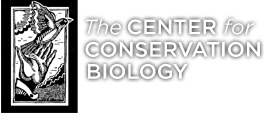
Master of Arts student, Department of Biology, College of William and Mary (1995-1998)
THESIS TITLE
Variation between sparrows in the ability to extract buried seed
THESIS ABSTRACT
Most North American sparrows forage almost exclusively on herbaceous seeds during the winter months. Limited amounts of surface seed force some birds to employ a bilateral scratching behavior to extract seeds buried beneath soil, snow, or litter. Artificial seed trays were used to test the ability of six different sparrow species to extract seed buried at different depths in soil. The results suggest three functional groups based on relative scratching ability. Strong scratchers, which included Eastern Towhee and Song and White-throated sparrows, met or exceeded their energetic requirements when foraging on seed buried at all depths (down to a maximum depth of 1.50-2.25 cm). A weak scratching species, Savannah Sparrow, scratched with the same frequency as the strong scratchers, but experienced negative energy budgets when forced to forage on sub-surface seed. Nonscratchers, which included Field Sparrow and Northern Cardinal, failed to secure any buried seed.
Level of scratching ability may impact foraging efficiency in habitats with low surface seed. As a result, interspecific differences in scratching ability may promote habitat selection. Strong scratchers may be adapted to foraging near woody vegetation where intense resource competition and abundant litter limit the availability of surface seed. Weak scratchers, on the other hand, may be forced to feed away from areas with little available surface seed. Since woody vegetation serves as a primary source of cover in early successional habitats, a tradeoff between foraging efficiency and the risk of predation may permit the local coexistence of species that differ in relative scratching ability and adaptations to evading predators.
Honor’s Student, Bachelor of Arts student, Department of Biology, College of William and Mary (1994-1995)
THESIS TITLE
The fall migration of the Northern Saw-whet Owl on the lower Delmarva Peninsula
THESIS ABSTRACT
Northern Saw-whet Owls (Aegolius acadicus) were captured and banded at 3 sites on the lower Delmarva Peninsula during the fall of 1994. Beginning on 27 October and ending on 12 December, 52 individual owls were caught and 28 recaptures occurred for a total of 80 owl captures. Of the 52 new owls, 5 were already banded at stations other than ours. The seasonal timing of migration was analyzed and 50% of new owl captures occurred between 10 and 19 November.
The majority of saw-whet owls captured (63%) were adults (after-hatch year). On a nightly basis, 48% of total owl captures occurred during the first 3 hours after sunset. New owl captures were distributed evenly between the bayside, the seaside and the tip of the peninsula. However, the bayside site accounted for fewer recaptures than expected. The majority of new owls were captured on nights when the temperature fell below 5° C. Recapture rate was not influenced by temperature. The rate of recaptures increased throughout the study and more than half of recaptures occurred after 25 November. Mean stopover time was 10.3 +/- 8. 7 days.
